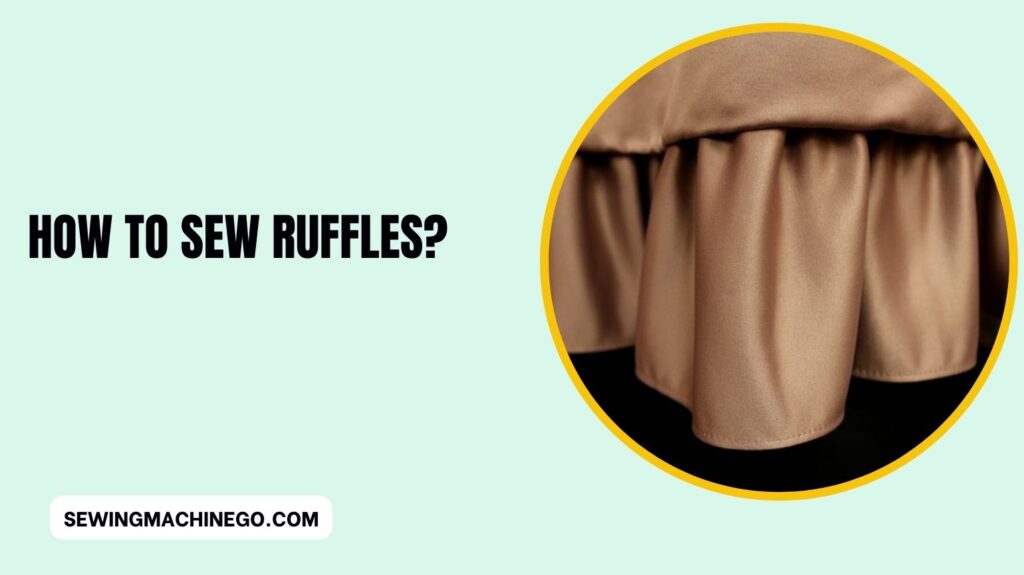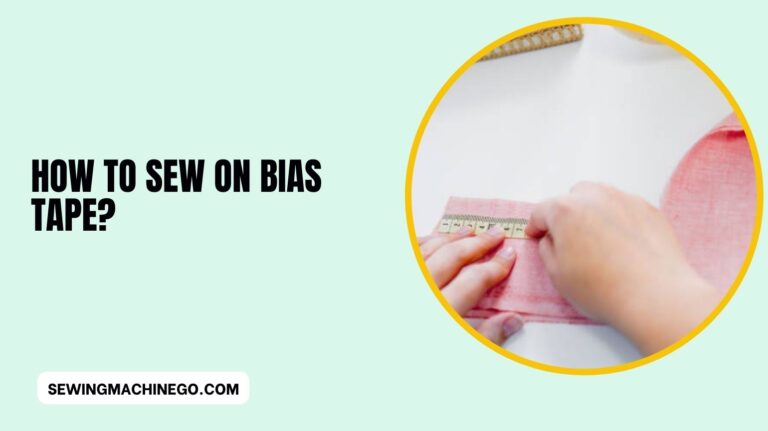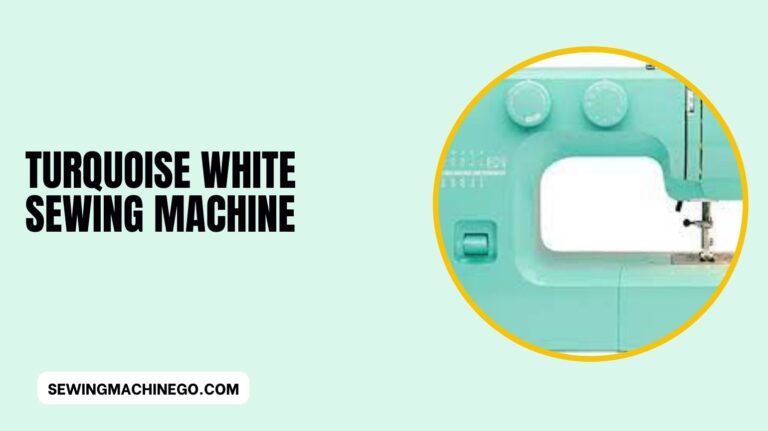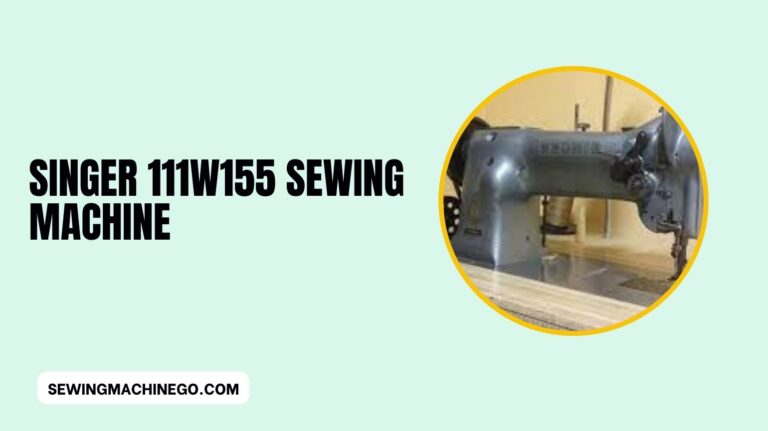How to Sew Ruffles? (Learn Step By Steps) In 2023
Sewing has always been a captivating craft, allowing individuals to express their creativity through fabric and thread.
How to Sew Ruffles? One particularly charming element that adds flair to various projects is the art of sewing ruffles.
In this article, we’ll dive into the world of ruffles, exploring the techniques, tools, and creative possibilities they offer.

Understanding Ruffles:
Ruffles, in the context of sewing, are gathered or pleated strips of fabric that create a wavy or frilly effect when attached to garments or other items.
These delightful additions can turn a simple piece into a statement of style and elegance.
Choosing the right fabric is crucial for achieving the desired ruffle effect, with lightweight and medium-weight fabrics often being the most suitable.
Essential Tools and Materials
Before diving into the delightful world of sewing ruffles, it’s crucial to gather the right tools and materials. Equipping yourself with the essentials ensures a smooth and enjoyable sewing experience.
Here’s a comprehensive list to get you started:
- Sewing Machine:
- A reliable sewing machine with adjustable settings is the backbone of your ruffling endeavors. Ensure it’s in good working condition and familiarize yourself with its features.
- Quality Thread:
- Choose a high-quality thread that complements your fabric. The thread color should match or harmonize with your chosen fabric to create a polished and cohesive look.
- Appropriate Needles:
- Select the right needles based on the type and weight of your fabric. Lightweight fabrics like chiffon may require a finer needle, while medium-weight fabrics like cotton may need a standard needle.
- Fabric Shears:
- Invest in a pair of sharp fabric shears dedicated solely to cutting fabric. Keeping them sharp ensures clean cuts and prevents fraying.
- Measuring Tape:
- Accurate measurements are key to achieving uniform ruffles. A flexible measuring tape helps you measure and cut fabric precisely.
- Marking Tools:
- Use chalk, fabric markers, or tailor’s pencils to mark guidelines on your fabric. Clear markings are essential for maintaining consistency in your ruffle pattern.
- Ruler or Seam Gauge:
- A ruler or seam gauge aids in measuring and marking even intervals for your ruffles. This is especially important for creating consistent and visually appealing ruffle patterns.
- Iron and Ironing Board:
- Preparing your fabric by washing and ironing ensures a smooth sewing process. An iron and ironing board are essential for achieving a polished finish on your ruffles.
- Pins or Clips:
- Secure fabric layers together with straight pins or fabric clips. These tools help maintain alignment and prevent fabric from shifting during the sewing process.
- Fabric:
- Choose a fabric suitable for creating ruffles. Lightweight and medium-weight fabrics like cotton, chiffon, organza, or tulle work well. The fabric should have the desired drape for optimal ruffle effect.
- Seam Ripper:
- Mistakes happen, and a seam ripper is your best friend for undoing stitches without damaging your fabric. Keep one on hand for troubleshooting any errors.
- Thimble:
- Protect your fingers from needle pricks by using a thimble, especially when hand-sewing portions of your ruffles.
- Pattern or Template (Optional):
- If you’re following a specific ruffle pattern or design, having a template or pattern can guide your cutting and sewing process for precise results.
- Serger (Optional):
- While not essential, a serger can provide a professional finish to the edges of your fabric, preventing fraying and enhancing the longevity of your ruffled creations.
- Pattern Weights (Optional):
- If you’re working with patterns or templates, pattern weights can hold them in place on your fabric, making it easier to trace and cut without using pins.
Preparing Fabric for Ruffles:
Start by preparing your fabric. Washing and ironing ensure that the fabric is clean and smooth, providing a solid foundation for beautiful ruffles.
Carefully cut fabric strips, and mark guidelines to maintain consistency in your ruffle pattern.
Techniques for Creating Ruffles:
There are various techniques for creating ruffles, each offering a unique result. Whether you prefer the simplicity of gathering,
the precision of pleating, or the efficiency of a ruffling foot attachment on your sewing machine, we’ve got you covered. Let’s walk through each technique step by step.
Choosing the Right Thread and Needle:
The quality of your thread and the choice of the needle can significantly impact the success of your ruffling endeavors.
Opt for a thread that matches your fabric and a needle suitable for its weight. This attention to detail ensures a polished and professional finish.
Troubleshooting Common Issues:
Encountering challenges during the ruffling process is not uncommon. Uneven ruffles or fabric bunching can be frustrating,
but fear not – we have practical tips for troubleshooting these issues without starting your project from scratch. Sewing ruffles can be immensely rewarding, but like any creative endeavor, it comes with its share of challenges.
Here are some common issues you might encounter and practical solutions to overcome them:
- Uneven Ruffles:
- Problem: Your ruffles appear uneven, with some sections more gathered than others.
- Solution: Ensure consistent tension on your fabric while sewing. Adjust your machine settings if needed and practice on scrap fabric to achieve an even ruffle pattern.
- Fabric Bunching:
- Problem: The fabric tends to bunch up as you sew, creating a messy and unprofessional look.
- Solution: Check the tension settings on your sewing machine. A too-tight tension can cause bunching. Additionally, use a suitable needle for your fabric type and ensure your machine is clean from lint or debris.
- Ruffle Breaks or Snaps:
- Problem: The thread holding your ruffles together breaks or snaps during sewing.
- Solution: Use a high-quality thread suitable for your fabric. Check for any knots or tangles in the thread, and make sure your machine is threaded correctly. If the issue persists, consider adjusting the tension or using a larger needle.
- Difficulty in Gathering Fabric:
- Problem: Gathering the fabric for ruffles is proving to be a challenging task.
- Solution: Use a longer stitch length and sew two parallel lines within the seam allowance. Gently pull the bobbin thread to gather the fabric. Additionally, you can invest in a ruffling foot for your sewing machine for more precise gathering.
- Ruffles are Too Stiff:
- Problem: The ruffles don’t have the desired softness and appear stiff.
- Solution: Choose a softer fabric, adjust your machine settings for a looser tension, and consider using a lighter thread. After sewing, gently press the ruffles with a warm iron to enhance their flow.
- Ruffles are Not Holding Shape:
- Problem: The ruffles lose their shape over time or after washing.
- Solution: Opt for fabrics with good recovery, meaning they bounce back to their original shape. Secure the ruffles with an additional stitch or two, especially at the beginning and end of the ruffle line. Follow proper care instructions when washing to maintain the shape.
- Inconsistent Ruffle Width:
- Problem: The width of your ruffles varies, creating an uneven appearance.
- Solution: Use a ruler or a seam gauge to measure and mark consistent intervals for your ruffles. Pay attention to your sewing speed and feed the fabric evenly through the machine to maintain a uniform width.
Incorporating Ruffles into Projects:
Now that you’ve mastered the art of creating ruffles, it’s time to explore how to incorporate them into your projects.
From clothing to home decor and accessories, ruffles can elevate the aesthetic of almost anything. We’ll showcase successful examples and offer ideas for your own creations.
Creative Ruffle Variations:
Unleash your creativity by exploring unique ruffle designs and patterns. Experimentation is encouraged, and personalization is key to making your ruffle projects truly one-of-a-kind.
Choosing the Right Thread and Needle:
Maintaining your ruffled creations is essential for longevity. Selecting the appropriate thread and needle is crucial in achieving a successful and durable sewing outcome.
The thread’s weight should complement the fabric’s weight and type, ensuring it can withstand the intended use and washing. Matching the needle size to the fabric weight prevents damage and ensures smooth stitching.
Consider the project’s requirements and fabric characteristics to choose the ideal combination, ensuring a seamless and sturdy finish.
Benefits of Learning to Sew Ruffles:
Embarking on the journey of learning to sew ruffles offers a range of benefits, both practical and personal. Here’s a closer look at why mastering the art of sewing ruffles can be a rewarding experience:
- Personal Satisfaction:
- Enjoy the sense of accomplishment and pride in creating beautiful and intricate ruffle designs.
- Cost-Effective Customization:
- Customize clothing and home decor inexpensively, giving your items a unique touch.
- Creativity Unleashed:
- Express your creativity by experimenting with different ruffle styles, fabrics, and patterns.
- Revitalize Old Items:
- Breathe new life into old garments or decor items by adding stylish ruffles.
- Versatility in Design:
- Gain the ability to enhance a wide range of projects, from clothing to accessories and beyond.
Inspiring Ruffle Projects:
To spark your imagination, we’ve gathered inspiring ruffle-based projects from the sewing community. Get ready to be amazed and motivated to embark on your ruffling journey.
Community and Online Resources:
Connect with fellow sewing enthusiasts through online resources. From websites and forums to social media groups, there’s a vibrant community eager to share tips, tricks, and inspiration.
People also ask
What is the best stitch for ruffles?
The best stitch for creating ruffles is the gathering stitch.
This stitch involves using a longer stitch length to create loose and even gathers in the fabric, allowing for easy manipulation and adjustment of the ruffle fullness.
Adjust the tension and stitch length on your sewing machine to achieve the desired ruffle effect while ensuring the stitches are secure enough to hold the gathers in place.
Are ruffles hard to sew?
Sewing ruffles isn’t inherently difficult, but it requires attention to detail. The key is understanding the techniques, using the right tools, and practicing patience.
With the proper preparation and a grasp of gathering or pleating methods, sewing ruffles can be an enjoyable and rewarding aspect of your sewing projects.
How do you sew ruffles on a sewing machine?
To sew ruffles on a sewing machine:
Set your machine to a longer stitch length.
Mark guidelines on your fabric.
Stitch a gathering stitch along the marked lines, leaving long thread tails.
Gently pull one of the threads to gather the fabric.
Distribute the gathers evenly.
Stitch over the gathers using a regular stitch to secure them in place.
Adjust the tightness of the gathers as needed.
What is the ratio for ruffles in sewing?
A common ratio for sewing ruffles is a 2:1 or 3:1 gathering ratio. This means that for every inch of fabric you want to ruffle, you gather two or three times that length.
Adjusting this ratio allows you to control the fullness of the ruffle, achieving either a subtle or more dramatic effect depending on your preference.
Conclusion – How to Sew Ruffles?
In Conclusion, Mastering the art of sewing ruffles adds depth and dimension to your creations, transforming the ordinary into the extraordinary.
Through this guide, you’ve discovered the steps to create beautiful ruffles, adding flair and texture to garments and projects.
Remember, the key lies in patience, precision, and choosing the right fabric and stitch settings.
Embrace this technique to infuse charm and elegance into your sewing repertoire, elevating your designs with delightful ruffled accents.
With practice and creativity, sewing ruffles becomes a skill that brings a touch of whimsy and sophistication to your sewing endeavors.

Hi, I am Alice, and I am your perfect guide to the world of sewing machines. With over 10 years of experience in the sewing industry, I am passionate about sharing my knowledge and expertise to help you make the most of your sewing journey. about me






